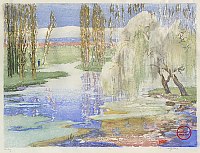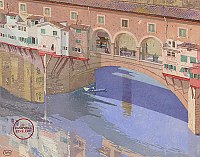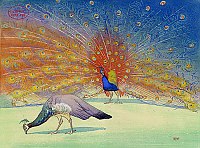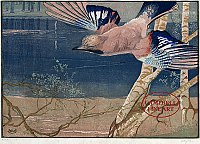 |
|
William Giles1872 - 1938 |
|
|
Click on a picture for more details |
|
|
President of the Society of Graver Printers in Colour, William Giles was one of the most important innovators in original colour printmaking in Britain during the first three decades of the twentieth-century. Having begun with the traditional colour woodcut method, he experimented widely, first with aquatint and then with relief printing from zinc plates in an attempt to produce pure, even areas of colour. He developed a novel range of inks ranging from watercolour mixed with rice paste, to powered colour dissolved in volatile oil, in order to achieve an ever greater range and depth of colour throughout his prints. His first experiments using zinc plates for relief printing date from 1902 and by 1920 William Giles had developed a novel technique using multiple zinc plates coated with shellac. Each zinc plate was inked to print a single colour from the raised areas of its etched surface and no ‘key block’ was used (the innovation of omitting the traditional ‘key block’ must now be regarded as one of Giles’s great contributions to the art of colour printing – a contribution which is normally accredited to Claude Flight). The result is a strikingly effective image with a myriad of fresh, even colours of a nature unique to the works of this pioneering artist. On occasions Giles used a combination of woodcut blocks and multiple zinc plates. It is quite possible that Giles formed the idea of using metal plates for relief printing from the example of William Blake who had used relief etched metal plates in a singular manner to print his remarkable illuminated books. William Blake was well known to all original printmakers of this period as one of the most innovative printmakers and greatest British arists of all time. Without the pioneering work of William Giles, the linocuts produced at the Grosvenor School of Modern Art might never have been created, for it was by following in his footsteps, using the type of inks which Giles had originated and printing single colours from cuts without a key block, as he had done, that Claude Flight, Cyril Power and Sybil Andrews developed the art of the linocut as a major and dramatic art form. William Giles had been acquainted with the founder of the Grosvenor School of Modern Art, Iain Macnab, for some time before the Grosvenor School was founded, both being fellow Scotsmen in the close circles of the London art world. It is seems fitting that the only known printed portrait of William Giles should have been made by yet another significant Scotsman in the world of printmaking, Ernest Stephen Lumsden. Inspired by the work of Frank Morley Fletcher, William Giles not only pioneered new colour printmaking techniques, based on the Japanese Ukiyo-e methods, but went on to establish the annual Original Colour Prints Magazine in 1924, hoping to attract the patronage of artists and specialist collectors by the inclusion of original woodcuts and bookplates. “Although it survived for only three issues until 1926, the Original Colour Prints Magazine remains significant in the history of the colour linocut because it was in its pages that Claude Flight first locked horns with those who defended established practices for making colour prints, due to F.M. Fletcher’s article asserting that linoleum “is not suited for printing a beautiful surface of colour…the result is poor”. With the stated purpose of refuting Fletcher’s assertion, Flight undertook to write his first book on colour printing from linoleum.” (Linocuts of the Machine Age by Stephen Coppel, Scolar Press, 1995, p.16). William Giles was elected president of the Society of Graver Printers in Colour in the mid-1920’s, succeeding Theodore Roussel who had been made its first president upon the foundation of the Society in 1909. [more] |






